| Weight | 1 lbs |
|---|---|
| Dimensions | 9 × 5 × 2 in |
| host | mouse |
| isotype | IgG |
| clonality | monoclonal |
| concentration | concentrate, predilute |
| applications | IHC |
| reactivity | human |
| available size | 0.1 mL, 0.5 mL, 1 mL concentrated, 7 mL prediluted |
rabbit anti-BRAF(V600E) monoclonal antibody (ZR6) 6036
Price range: $160.00 through $528.00
Antibody summary
- Rabbit monoclonal to BRAF(V600E)
- Suitable for: Immunohistochemistry (formalin-fixed, paraffin-embedded tissues)
- Reacts with: Human
- Isotype:IgG
- Control: Melanoma with V600E mutation
- Visualization: Nuclear
- 0.1, 0.5, 1.0 mL concentrated, 7 mL prediluted
rabbit anti-BRAF(V600E) monoclonal antibody ZR6 6036
| target relevance |
|---|
| Protein names Serine/threonine-protein kinase B-raf (EC 2.7.11.1) (Proto-oncogene B-Raf) (p94) (v-Raf murine sarcoma viral oncogene homolog B1) |
| Gene names BRAF,BRAF BRAF1 RAFB1 |
| Protein family Protein kinase superfamily, TKL Ser/Thr protein kinase family, RAF subfamily |
| Mass 84437Da |
| Function FUNCTION: Protein kinase involved in the transduction of mitogenic signals from the cell membrane to the nucleus (Probable). Phosphorylates MAP2K1, and thereby activates the MAP kinase signal transduction pathway (PubMed:21441910, PubMed:29433126). Phosphorylates PFKFB2 (PubMed:36402789). May play a role in the postsynaptic responses of hippocampal neurons (PubMed:1508179). {ECO:0000269|PubMed:1508179, ECO:0000269|PubMed:21441910, ECO:0000269|PubMed:29433126, ECO:0000269|PubMed:36402789, ECO:0000305}. |
| Catalytic activity CATALYTIC ACTIVITY: Reaction=L-seryl-[protein] + ATP = O-phospho-L-seryl-[protein] + ADP + H(+); Xref=Rhea:RHEA:17989, Rhea:RHEA-COMP:9863, Rhea:RHEA-COMP:11604, ChEBI:CHEBI:15378, ChEBI:CHEBI:29999, ChEBI:CHEBI:30616, ChEBI:CHEBI:83421, ChEBI:CHEBI:456216; EC=2.7.11.1; Evidence={ECO:0000269|PubMed:21441910, ECO:0000269|PubMed:29433126}; CATALYTIC ACTIVITY: Reaction=L-threonyl-[protein] + ATP = O-phospho-L-threonyl-[protein] + ADP + H(+); Xref=Rhea:RHEA:46608, Rhea:RHEA-COMP:11060, Rhea:RHEA-COMP:11605, ChEBI:CHEBI:15378, ChEBI:CHEBI:30013, ChEBI:CHEBI:30616, ChEBI:CHEBI:61977, ChEBI:CHEBI:456216; EC=2.7.11.1; Evidence={ECO:0000269|PubMed:21441910}; |
| Subellular location SUBCELLULAR LOCATION: Nucleus {ECO:0000250}. Cytoplasm {ECO:0000269|PubMed:19710016}. Cell membrane {ECO:0000269|PubMed:19710016}. Note=Colocalizes with RGS14 and RAF1 in both the cytoplasm and membranes. {ECO:0000250}. |
| Tissues TISSUE SPECIFICITY: Brain and testis. |
| Structure SUBUNIT: Monomer (PubMed:19710016). Homodimer (PubMed:19710016, PubMed:36402789). Heterodimerizes with RAF1, and the heterodimer possesses a highly increased kinase activity compared to the respective homodimers or monomers (PubMed:19710016). Heterodimerization is mitogen-regulated and enhanced by 14-3-3 proteins. MAPK1/ERK2 activation can induce a negative feedback that promotes the dissociation of the heterodimer by phosphorylating BRAF at Thr-753. Heterodimerizes (via N-terminus) with KSR1 (via N-terminus) or KSR2 (via N-terminus) in a MAP2K1-dependent manner (PubMed:29433126). Interacts with MAP2K1 and MAP2K2 (PubMed:29433126). Found in a complex with at least BRAF, HRAS, MAP2K1, MAPK3 and RGS14. Interacts with RIT1. Interacts (via N-terminus) with RGS14 (via RBD domains); the interaction mediates the formation of a ternary complex with RAF1, a ternary complex inhibited by GNAI1 (By similarity). Interacts with DGKH (PubMed:19710016). Interacts with PRMT5 (PubMed:21917714). Interacts with KSR2 (PubMed:21441910). Interacts with AKAP13, MAP2K1 and KSR1. Identified in a complex with AKAP13, MAP2K1 and KSR1 (PubMed:21102438). Interacts with FNIP1 and FNIP2 (PubMed:27353360). {ECO:0000250, ECO:0000269|PubMed:18287029, ECO:0000269|PubMed:19710016, ECO:0000269|PubMed:21102438, ECO:0000269|PubMed:21441910, ECO:0000269|PubMed:21917714, ECO:0000269|PubMed:27353360, ECO:0000269|PubMed:29433126, ECO:0000269|PubMed:36402789}. |
| Post-translational modification PTM: Phosphorylation at Ser-365 by SGK1 inhibits its activity (Ref.8, PubMed:11410590). Phosphorylation at Thr-753 by MAPK1 (PubMed:19710016). Dephosphorylation of Ser-365 by the SHOC2-MRAS-PP1c (SMP) complex consisting of SHOC2, GTP-bound M-Ras/MRAS and the catalytic subunit of protein phosphatase 1 (PPP1CA, PPP1CB or PPP1CC); this relieves inactivation and stimulates kinase activity (PubMed:35768504, PubMed:35830882). {ECO:0000269|PubMed:11410590, ECO:0000269|PubMed:19710016, ECO:0000269|PubMed:35768504, ECO:0000269|PubMed:35830882, ECO:0000269|Ref.8}.; PTM: Methylation at Arg-671 decreases stability and kinase activity. {ECO:0000269|PubMed:21917714}.; PTM: Ubiquitinated by RNF149; which leads to proteasomal degradation. Polyubiquitinated at Lys-578 in response to EGF. {ECO:0000269|PubMed:22628551, ECO:0000269|PubMed:23907581}. |
| Involvement in disease DISEASE: Note=Defects in BRAF are found in a wide range of cancers. {ECO:0000269|PubMed:18974108}.; DISEASE: Colorectal cancer (CRC) [MIM:114500]: A complex disease characterized by malignant lesions arising from the inner wall of the large intestine (the colon) and the rectum. Genetic alterations are often associated with progression from premalignant lesion (adenoma) to invasive adenocarcinoma. Risk factors for cancer of the colon and rectum include colon polyps, long-standing ulcerative colitis, and genetic family history. {ECO:0000269|PubMed:12198537, ECO:0000269|PubMed:21917714, ECO:0000269|PubMed:23263490, ECO:0000269|PubMed:24455489}. Note=The disease may be caused by variants affecting the gene represented in this entry.; DISEASE: Lung cancer (LNCR) [MIM:211980]: A common malignancy affecting tissues of the lung. The most common form of lung cancer is non-small cell lung cancer (NSCLC) that can be divided into 3 major histologic subtypes: squamous cell carcinoma, adenocarcinoma, and large cell lung cancer. NSCLC is often diagnosed at an advanced stage and has a poor prognosis. {ECO:0000269|PubMed:12460919}. Note=The gene represented in this entry is involved in disease pathogenesis.; DISEASE: Familial non-Hodgkin lymphoma (NHL) [MIM:605027]: Cancer that starts in cells of the lymph system, which is part of the body's immune system. NHLs can occur at any age and are often marked by enlarged lymph nodes, fever and weight loss. {ECO:0000269|PubMed:14612909}. Note=The gene represented in this entry is involved in disease pathogenesis.; DISEASE: Cardiofaciocutaneous syndrome 1 (CFC1) [MIM:115150]: A multiple congenital anomaly disorder characterized by a distinctive facial appearance, heart defects and intellectual disability. Heart defects include pulmonic stenosis, atrial septal defects and hypertrophic cardiomyopathy. Some affected individuals present with ectodermal abnormalities such as sparse, friable hair, hyperkeratotic skin lesions and a generalized ichthyosis-like condition. Typical facial features are similar to Noonan syndrome. They include high forehead with bitemporal constriction, hypoplastic supraorbital ridges, downslanting palpebral fissures, a depressed nasal bridge, and posteriorly angulated ears with prominent helices. {ECO:0000269|PubMed:16439621, ECO:0000269|PubMed:16474404, ECO:0000269|PubMed:18042262, ECO:0000269|PubMed:19206169}. Note=The disease is caused by variants affecting the gene represented in this entry.; DISEASE: Noonan syndrome 7 (NS7) [MIM:613706]: A form of Noonan syndrome, a disease characterized by short stature, facial dysmorphic features such as hypertelorism, a downward eyeslant and low-set posteriorly rotated ears, and a high incidence of congenital heart defects and hypertrophic cardiomyopathy. Other features can include a short neck with webbing or redundancy of skin, deafness, motor delay, variable intellectual deficits, multiple skeletal defects, cryptorchidism, and bleeding diathesis. Individuals with Noonan syndrome are at risk of juvenile myelomonocytic leukemia, a myeloproliferative disorder characterized by excessive production of myelomonocytic cells. {ECO:0000269|PubMed:19206169}. Note=The disease is caused by variants affecting the gene represented in this entry.; DISEASE: LEOPARD syndrome 3 (LPRD3) [MIM:613707]: A disorder characterized by lentigines, electrocardiographic conduction abnormalities, ocular hypertelorism, pulmonic stenosis, abnormalities of genitalia, retardation of growth, and sensorineural deafness. {ECO:0000269|PubMed:19206169}. Note=The disease is caused by variants affecting the gene represented in this entry.; DISEASE: Note=A chromosomal aberration involving BRAF is found in pilocytic astrocytomas. A tandem duplication of 2 Mb at 7q34 leads to the expression of a KIAA1549-BRAF fusion protein with a constitutive kinase activity and inducing cell transformation. {ECO:0000269|PubMed:18974108}. |
| Target Relevance information above includes information from UniProt accession: P15056 |
| The UniProt Consortium |
Data
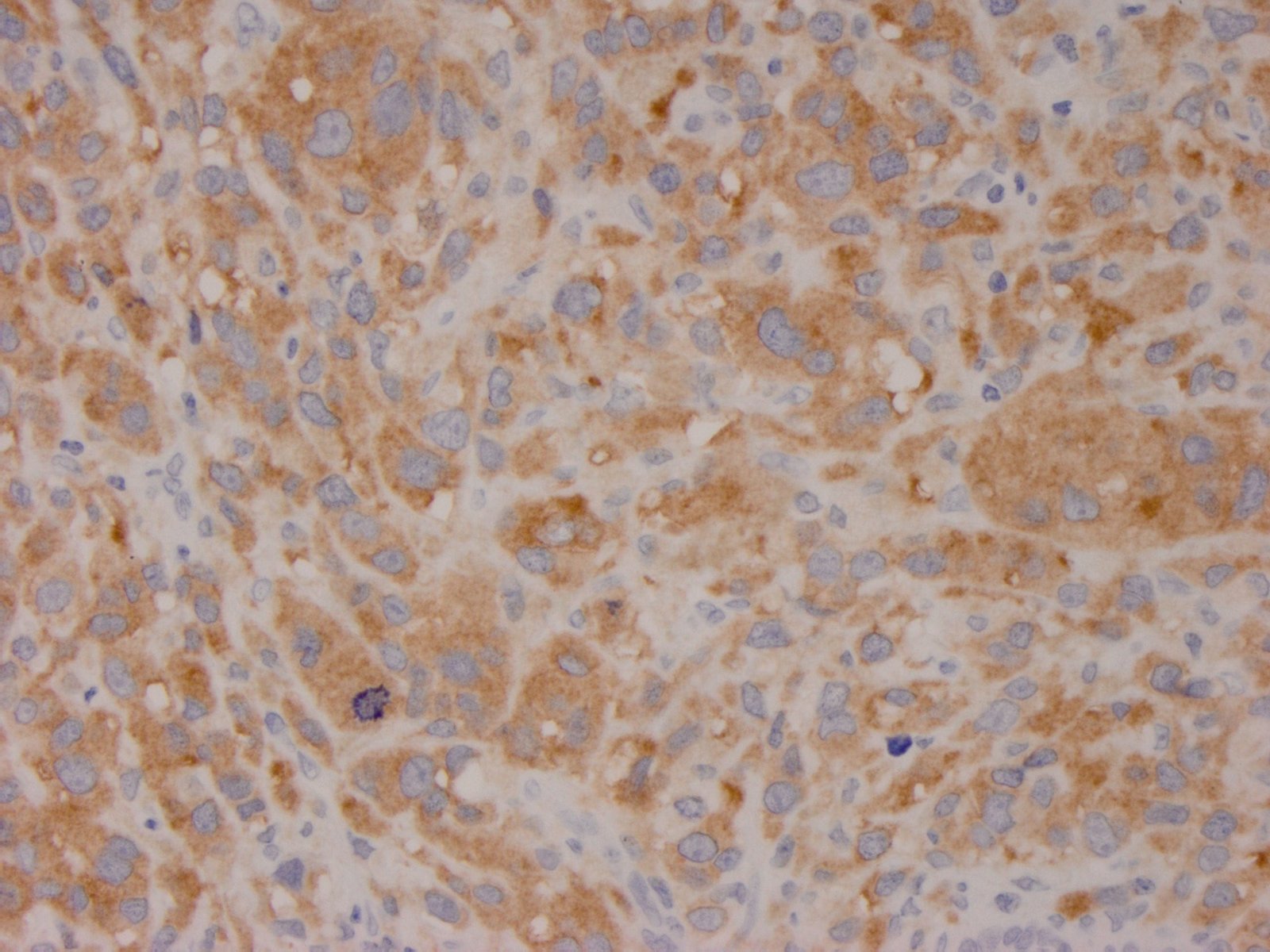 |
| Formalin-fixed, paraffin-embedded human melanoma stained with anti-BRAF (V600E) antibody using peroxidase-conjugate and DAB chromogen. Note cytoplasmic staining of tumor cells with V600E mutation |
Publications
| pmid | title | authors | citation |
|---|---|---|---|
| We haven't added any publications to our database yet. | |||
Protocols
| relevant to this product |
|---|
| IHC |
Documents
| # | SDS | Certificate | |
|---|---|---|---|
| Please enter your product and batch number here to retrieve product datasheet, SDS, and QC information. | |||
Only logged in customers who have purchased this product may leave a review.

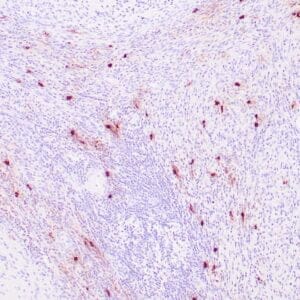


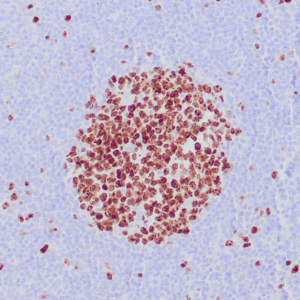
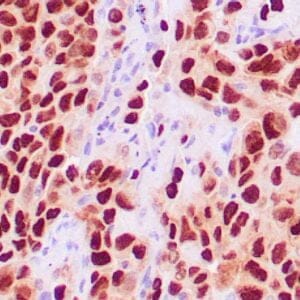
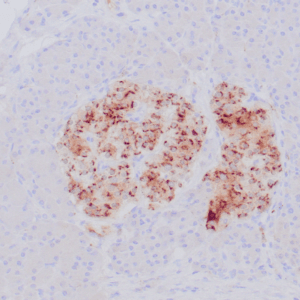

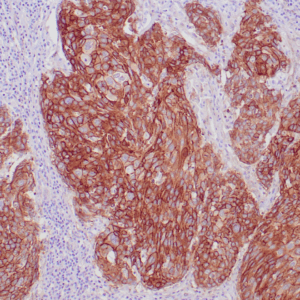
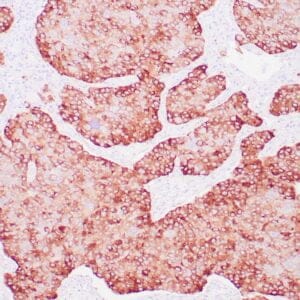
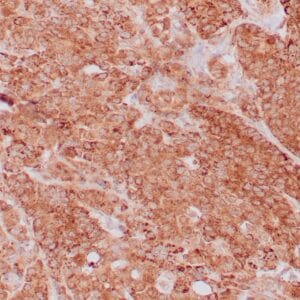
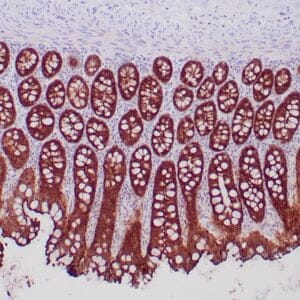


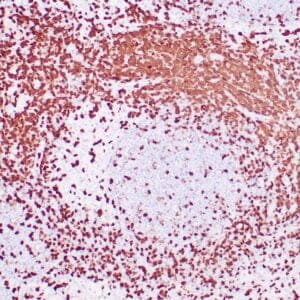
Reviews
There are no reviews yet.